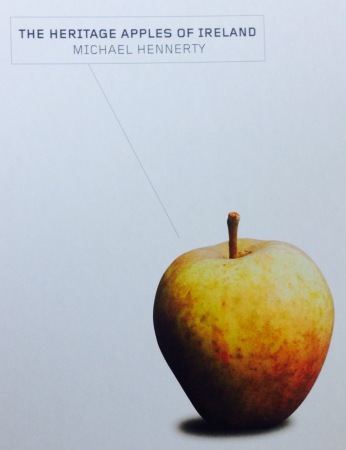 Our office complimentary copy of Michael Hennerty’s The Heritage Apples Of Ireland has arrived, and it’s a real beauty. We somehow missed the announcement of its publication back in the summer.
Our office complimentary copy of Michael Hennerty’s The Heritage Apples Of Ireland has arrived, and it’s a real beauty. We somehow missed the announcement of its publication back in the summer.
The book is written by Dr. Michael Hennerty, who for many years was Head of the Department of Horticulture in University College Dublin, and provides detailed genetic information of 68 different varieties of indigenous Irish apples using high resolution photographs. The descriptors used in the book utilise the current internationally recognised descriptor system and a key is also included to facilitate the identification of historical Irish cultivars by non-experts.
I particularly like the section on “finders and keepers”, people who have been involved in the conservation of Irish apples over the years. People like John George Dalkeith Lamb, who…
…collected old apples from 1945 to 1949 and established the UCD collection. Prof. E.J. Clarke maintained the collection until it was destroyed in 1970. Repatriated in 1996. Now planted at UCD, Belfield, Dublin.
That “repatriated” is intriguing, but I can find no further explanation of it online. Anyone out there know the details?
Another fine book on apples and pears was recently published by the Museum of Economic Botany, Adelaide Botanic Gardens.
Tony Kanellos (2013) Imitation of Life: A Visual Catalogue of the 19th Century. Fruit Models in the Santos Museum of Economic Botany in the Adelaide Botanic Garden, a Collection of Papier Mâché Models Made by Heinrich Arnoldi & Co. Gotha, Germany (1856–1899). Board of the Botanic Gardens and State Herbarium: Adelaide, 2013. 384 pp., ISBN: 9780980702163 (HB)
For a review see http://www.publish.csiro.au/?act=view_file&file_id=HR14009.pdf
Where can I get this book please?
Amazon? The first link in the post will take you straight there. Or, of course, a bookshop.
Hi Luigi, I met a follower of your blog recently who told me about your unanswered query on the “repatriation” of the Irish Apple Collection.
I work for the Irish Seed Savers Association and have collaborated with UCD on this book and other mutual projects concerning the Heritage Apples of Ireland, so hopefully I can help explain the background story a little bit. Do bear in mind though that my own information is based on second-hand information – I hope I have the detail right:
When Dr. Lamb established the Heritage Apple collection at UCD (then Albert College campus) he also sent cuttings of the varieties to the UK National Fruit Collection (Brogdale, Kent, UK). The varieties were propagated and planted at Brogdale too as a back-up, and also because the UK and Ireland share such an intertwined agricultural and social history and links that many Irish varieties became popular in the UK and vice-versa.
When the collection at Albert college was erroneously bulldozed by construction/development workers, the irish apple trees in the Brogdale collection became the source for “repatriation” of the varieties. This was delayed and complicated by Plant Health restrictions to do with ‘fireblight’ a very destructive disease of the Rose family which includes apples, pears, etc… Importation of plant material into Ireland from the UK is very restricted for host plant species. However, quarantine and other arrangements were eventually put in place to successfully bring the varieties back to Ireland. By then UCD had moved from Albert College campus to its current Belfield campus. The new orchard is part of the Rosemount horticultural station at Belfield.
Cuttings of the same varieties were also sent to the Irish Seed Savers Association in Co. Clare as a duplicate collection. The Irish Seed Savers Association had begun a project to try to resource the same varieties in-situ in old orchards across Ireland, and to also try to find some of the ‘missing’ varieties from Dr. Lamb’s original thesis.
UCD and ISSA have continued to work together over subsequent years and between them have successfully added missing varieties to the collection. This work is on-going and we hope to collaborate on a 2nd edition of the book in a few years time to present the updated collection.
The 1st edition of the book is now sold-out of all copies of the print-form (It had been for sale from our farm-shop and website), and so is now only available as an e-book from amazon. Copies had been sent to many libraries around the country, so hopefully they are accessible to the Irish public from there.
Hello, I’ve just come across this thread in searching for the book. Does anyone know where I can get a copy or ebook version now? It doesn’t seem to be available on Amazon anymore unfortunately and I’m very keen to read it. I’m not in Ireland so can’t access the libraries. Thank you, David
You can get it from the library but I can’t find a copy anywhere I did get a copy from some Malaysian ebook store but it didn’t have photos cost me 80 and after a month the book expired so I can’t read it now